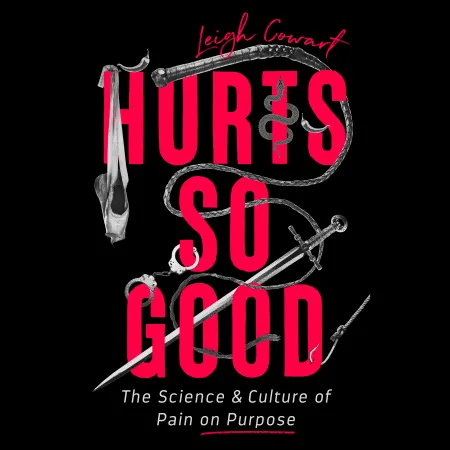In academic circles, we have a half-joking-but-not-really saying: “All Research Is Me-Search,” and Leigh Cowart’s new book has taken that dictum to titanic new heights and visceral, evocative depths.
Cowart is a former ballet dancer, a biologist who researched Pteronotus bats in the sweltering jungles of Costa Rica, and a self-described “high-sensation-seeking masochist.” They wrote this book to explore why they were like this, and whether their reasons matched up with those of so many other people who engage is painful activities of their own volition, whether for the pain itself, or the reward afterward. Full disclosure: Leigh is also my friend, but even if they weren’t, this book would have fascinated and engrossed me.
Hurts So Good is science journalism from a scientist-who-is-also-a-journalist, which means that the text is very careful in who and what it sources, citing its references, and indexing terms to be easily found and cross-referenced, while also bringing that data into clear, accessible focus. In that way, it has something for specialists and non-specialists, alike. But this book is also a memoir, and an interior exploration of one person’s relationship to pain, pleasure, and— not to sound too lofty about it— the whole human race.
The extraordinarily personal grounding of Hurts So Good is what allows this text to be more than merely exploitative voyeurism— though as the text describes, exploitative voyeurism might not necessarily be a deal-breaker for many of its subjects; just so long as they had control over when and how it proceeds and ends. And that is something Cowart makes sure to return to, again and again and again, turning it around to examine its nuances and infinitely fuzzy fractaled edges: The difference between pain that we instigate, pain that we can control, pain we know will end, pain that will have a reward, pain we can stop when and how we want… And pain that is enforced on us.
Cowart writes again and again that if BDSM is not consensual then it is abuse, that the forms of training done in ballet have a direct effect on disordered eating and body image issues, and that the kinds of pain which are not in our control can contribute to lasting trauma. And they also discuss how healing it can be to take back the control of pain in consensual BDSM, or the story of a ballet dancer who found themselves drawn to mixed martial arts as a way to process what was done to them in the ballet studio, and how using therapy to recognize and grapple with what has been done to us can sometimes allow us to differently understand what we want for ourselves.
There are no firm answers, in Cowart’s book. There are multiple perspectives, from neuroscientists, to the aforementioned ballerinas-turned-MMA-fighters, to ultra-marathoners, to people who compete to eat the hottest chilies in the world, to people who pierce the skin of their backs to hang suspended from hooks and bars, in public, to polar bear plungers, and more. There are overlapping feelings and descriptions in all of these people who seek to experience pain on purpose, but there is also a stunning multiplicity of backgrounds, of beliefs, of reasons to seek these avenues out, each one helping the reader to understand something more about both individual psychology and whole cultures’ relationships to pain.

[Cover image for Hurts So Good, featuring various hot peppers, handcuffs, a sword, a whip, a snake, a hook on the end of a rope, and pointe shoes, all arranged around the words “Leigh Cowart— Hurts So Good— The Science & Culture of Pain on Purpose]
As someone who studies, among other things, the intersections of religious belief, ritual, and social life, I was absolutely fascinated by Cowart’s discussion of the role of ritual in how we experience pain and pleasure, both in the context of the preparations for dance or other sport or how competitors psych themselves up before a chili eating match or the constant call-and-response and check-in and aftercare process of a BDSM scene, but also in terms of literal religious ceremonies. Cowart discusses the flagellants of the Black Plague era, and mystics who fasted and meditated to achieve oneness with the Divine (a practice that also had clear gender-political valences, which Cowart also gets into). So one thing I’d’ve loved more of from Cowart is what other religious groups they found also use pain in a spiritual context. I know of a few, myself, including schools of Zen Buddhism, and would have loved to have them alongside Cowart’s examples, as well.
Similarly, I greatly appreciated Cowarat’s exploration of the link between the psychological, emotional, and the physical, in categorizing and inscribing pain in the bodymind. I know firsthand that graduate school and academic research is often about enduring the emotional and psychological kinds of pain, for the sake of something more coming out of it, as well as for what we believe we can achieve in that moment, and so I would have loved even a bit more in psychological and emotional veins, too.
But, of course, when writing a book, we have the time we have, and the time that Leigh Cowart took to research and write their book was well worth it.
Hurts So Good: The Science and Culture of Pain on Purpose is an illuminating, joyous, deeply emotional examination of what makes pain what it is, what makes pain mean what means, and why. And what could be more fitting for one of the most intimate, personal, and universal experiences of the human species.
Hurts So Good is out now from Public Affairs and Hachette, and if you want more from Leigh, you can check out their appearance on NPr’s The 1a.


